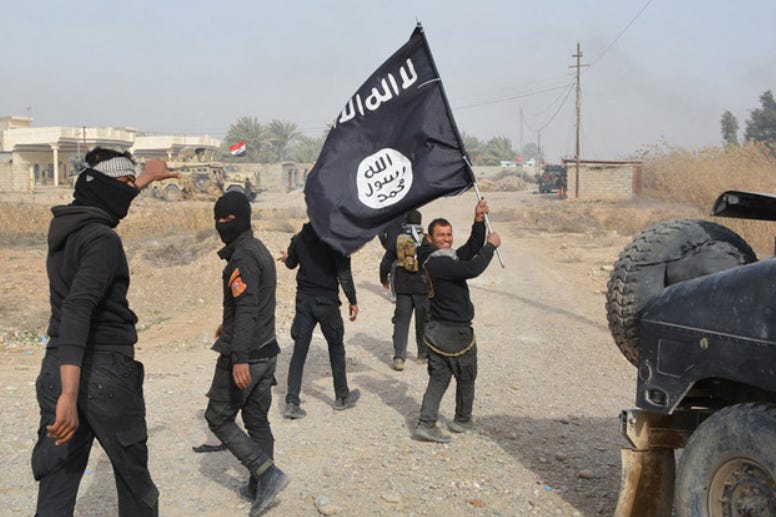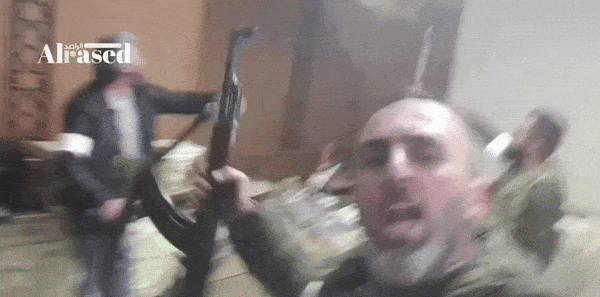The South has Risen... Again
Southern Syria has seen the regime collapse and the rebels take charge in record time. But who are these rebels? And are they related to the ones in the north?
(Lightly edited in light of the fall of the Assad regime)
Things are moving fast in Syria, so much so that the rebels themselves are probably confused.
But understanding these groups is crucial to figuring out where this war is going. As we’ll see, the “rebels” aren’t a monolith, with each group having competing interests and desires. That’s why it’s important to know which rebel groups are which when the news says “rebels have taken X or Y town.” This understanding will enable us to better predict what’s going to happen within Syria, and what the third order effects of those actions might be.
I’m going to put this map here, a map which shows territorial control accurate to Saturday evening at 8pm Israel/Syria time.
(Source)
Are you ready for things to get complex? Tayeb yalla come on let’s gooooooooo!!!!!
Black area (ISIS)
This area is controlled by ISIS.
After the terror supergroup was defeated, it never really went away. The organization was at one point in control of one third of all of Syria and about 40% of Iraq, making it larger than the UK. However, following a concerted effort by basically the entire world, it was destroyed and forced to go out into these desert pockets.
(Source: Getty)
With the recent upheaval in Syria, ISIS has been able to take some more territory and more villages. It’s probably not enough to make a huge difference at this point, but it does prove they’re still active players in this conflict.
Big Light Green area (Al Tanf)
This is the al-Tanf region on the tri-border with Syria, Jordan, and Iraq. It’s controlled by the Syrian Free Army (SFA) or New Syrian Army (NSA). There’s also a US military base here. The area has been deemed a “deconfliction zone,” ie an area where Syrian, Russian, and Iranian backed forces are prohibited from operating. There is a large refugee camp here called the Rukban refugee camp, hosting anti-regime Syrians.
For years, this base is where US and partner forces trained the SFA. However, President Donald Trump ended this training program in 2017. Despite this, the US has maintained a troop presence in the area. The base even came under drone attack in June of 2024, killing three US troops and injuring 34.
(Al Tanf Airbase with US and SFA vehicles - Source: Wiki Commons)
Between Thursday, December 3 – Saturday December 7, 2024, SFA troops stormed out of this enclave and captured huge swaths of territory. They even captured the key city of Palmyra on Saturday, as well as the T4 Syrian Airforce Base. The T4 base was used by Hezbollah as a drone base, where weapons were transferred from Iran to Hezbollah, and has been attacked by Israel several times. Meanwhile, Palmyra is a key strategic city in the desert, and has been considered as such for at least 4,000 years. Whoever controls this desert city controls the east-west axis between Iraq and the Mediterranean sea.
Of course, the SFA is not to be confused with the Free Syrian Army (FSA) which is backed by Turkey (and the US, kind of), is mainly in the north, and was covered in a previous post.
Light Green Area in the Deep South (Deraa, Suweida, Qunietra)
This area has seen incredible change over the past few days. On Friday morning this entire area was still blood red and fully under the Assad regime’s control. But within 36 hours local rebel factions took control of all three of these major areas.
It’s important to note that the rebels in the north are NOT the same as the ones in the south. The guys in the north include Hayat Tahrir a-Sham while the ones in the south are assorted anti-Assad rebel groups. They including secular rebel factions, Druze rebel groups, and jihadist groups.
(An abandoned Syrian army APC in Deraa - Source: EPA)
Deraa, which is where this present revolt in the south really got started, is also where the Syrian civil war started back in 2011. The city has remained an important place in the hearts of Syrians ever since. However, despite being the birthplace of the revolution, it was reverted back to Assad regime control in the Astana agreement (basically, this agreement froze the civil war).
Something to remember is that there was a large ISIS an al-Qaida presence in southern Syria before the freeze. The groups may have lost territory, but the ideology still remains in these areas. And the former members of these groups still have their weapons.
A drug superhighway
With this freeze, Assad turned the south of the country into a smuggling superhighway for Captagon (Arab meth), smuggling it through Jordan and making billions. However, this didn’t always please the locals. So, the Assad regime went back to it’s thuggish ways, and killed and kidnapped anyone who stood in its way.
But the local population wouldn’t be pushed around so easily this time. After all, they had just fought a civil war against the regime, and many of the former rebels still had their weapons and chains of command. The former rebel groups essentially became mafias who wouldn’t hesitate to fight against the Syrian regime if they felt threatened.
And fight they did. For instance any time the Syrian regime kidnapped a Druze family to pressure the Druze leadership into doing something or to get better smuggling rates, the Druze militia would kidnap a Syrian officer in the area. Or, if a regime captagon smuggler was going through an area with a lot of former rebels without proper authorization from group, the former rebels would kidnap and potentially kill the smuggler or even Assad police forces.
By the way, this has presented a huge problem for Jordan, whose forces would regularly get into shootouts with smugglers – regime and non-regime alike - along its border with Syria. Jordanian soldiers have died in these shootouts, Jordanian airstrikes have killed suspected drug smugglers and their families inside of Syria, and there was even talk of Jordan creating a buffer zone within Syria to prevent this.
(Captagon pills from Syria seized in Jordan - Source: Reuters)
The Druze
A HUGE factor in this sector are the Druze. It’s important to note that this religious group is not Muslim. Because of this, they always have a target on their backs from the other rebel groups, especially the more jihadi inclined. As a result, they’re very close knit, and act under the assumption that the only people who’ll look out for their interests are themselves. The Druze have historically lived on Mt. Druze, and the majority of the Druze in Syria live in and around the town of Suweida, which is, of course, on Mt. Druze.
The Druze religion requires its adherents to pledge their allegiance to whatever sovereign rules the area they live in and be super nationalistic towards that state. Before the Syrian civil war, the Druze served loyally as officers and ministers in the Syrian military and government. However, this changed once the war started, and they formed their own militia, called the Al Karama brigades.
The Al Karama Brigades sided with the rebels, but they were never really 100% “in” with them, mainly trying to keep to themselves and make sure no one attacked them. The rebels weren’t totally fans of the Druze either. The secular rebels didn’t trust them because of their former associations with the Assad regime, and the Islamist rebels (including Al Qaeda and ISIS) didn’t like them because they’re considered “apostates” and not true Muslims.
Today, the Druze have taken matters into their own hands, re-vamping the al Karama brigades (who up until now were focused on revenge killings and kidnappings against the Assad regime and jihadi groups), and expelling the Assad regime from Mt. Druze.
(Members of the Al Karama brigade destroying the central Ba’ath party offices in Suweida)
Currently, all the rebel groups are anti-Assad and working together in harmony. A big old kumbaya of revolution. But will this rainbow coalition of unity hold?
So What Happens Next?
There are a lot of interesting things to think about given the events of the past few days. At the time of this writing, the rebels from the Deraa area are at the suburbs of Damascus and are preparing to continue their push north into the city. They have captured the airbase in Suweida and will soon capture the one in Mazzeh, outside Damascus. Meanwhile, the SFA aren’t too far away from linking up with HTS and the rebels from the north.
It's impossible to say what will happen at the end of this war, but here is what I think will happen if the rebels take over Syria:
The leader of HTS, Abu Mohammed al-Jolani, has said that he intends to march on Damascus, overthrow the Assad regime, and then be installed as ruler of Syria.
BUT, he isn’t the only rebel leader making huge gains. There are also the rebels from the south, the SFA, the FSA, the SDF, whoever is left of the Syrian Arab Army, and more. Will they all submit to al-Jolani, who has openly said he wants a “moderate” Islamic dictatorship? Or will his refusal to cede power cause a much larger, 100 sided civil war to break out?
Unless a lot of people get really cool with a lot of things really quickly, I don’t see Jolani fulfilling his dream of controlling Syria. Instead, I believe there will be a large, multi-sided civil war. I believe the Kurds will refuse to give up on their dreams of independence in the northeastern corner of Syria, I don’t believe the Druze fully trust anyone to rule over them fairly, I don’t trust HTS to abide by their claims of being pluralistic and moderate, I don’t believe ISIS and the other fundamentalist groups will see HTS as Muslim enough, and I don’t believe the FSA will accept Islamist leadership.
The enormous inherent differences, mindsets, and religious views of these groups makes any type of nation building an enormous challenge, and I don’t believe they’re reconcilable. They all need a boogeyman to rally against in order to unite. And now, the boogeyman Assad regime is gone.
Let’s see what happens…









